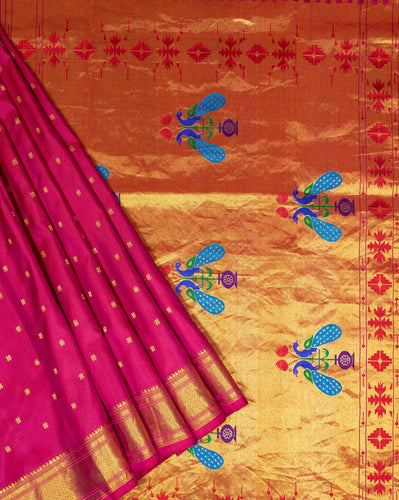The Role of Pure Silk and Zari in Authentic Paithani Sarees

The Role of Pure Silk and Zari in Paithani Sarees
Paithani sarees, known as the "Queen of Silks," owe much of their allure and elegance to the meticulous use of pure silk and zari. These two elements not only define the saree’s luxurious feel and intricate beauty but also symbolize the heritage and craftsmanship of Indian textiles. Let’s explore the crucial role that pure silk and zari play in crafting authentic Paithani sarees.
1. The Foundation of Pure Silk
-
Quality and Texture:
Pure mulberry silk forms the base fabric of Paithani sarees. Known for its smooth, soft texture and durability, it ensures the saree's premium quality. -
Vibrant Colors:
Silk threads are dyed in rich, vibrant colors using traditional or natural dyes. The interplay of hues enhances the saree’s iridescent effect, a hallmark of Paithani weaving. -
Weaving the Body:
The body of the saree is woven using fine silk threads in both the warp (lengthwise threads) and weft (crosswise threads). This creates a dense, luxurious texture that drapes gracefully.
2. The Elegance of Zari
-
What is Zari?
Zari is made by winding thin gold or silver-coated metallic threads around a core of silk or cotton. In Paithani sarees, zari is an essential component, particularly for the borders and pallu. -
Authentic Gold and Silver Zari:
Historically, pure gold and silver zari were used, making the sarees highly valuable. Today, while traditional artisans still use authentic zari, modern variations sometimes include synthetic alternatives for affordability. -
Ornate Borders and Pallu:
The zari threads are woven into intricate designs on the saree's borders and pallu. Signature motifs like peacocks, lotuses, and creepers shimmer against the silk backdrop, creating a regal appeal.
3. The Interplay of Silk and Zari
-
Kaleidoscopic Effect:
Pure silk in contrasting warp and weft threads creates a shimmering, dual-tone effect, while zari adds metallic brilliance, enhancing the saree’s visual impact. -
Motif Detailing:
The intricate motifs on Paithani sarees rely on a combination of silk and zari to achieve the perfect balance of vibrancy and elegance. Zari outlines and fills in patterns, while silk provides a vivid base. -
Durability and Longevity:
The use of high-quality silk and zari ensures that authentic Paithani sarees are durable and maintain their beauty over decades, often passed down as heirlooms.
4. Cultural and Symbolic Importance
-
Symbol of Wealth and Prestige:
The use of silk and zari, historically reserved for royalty and the elite, makes Paithani sarees a symbol of affluence and cultural pride. -
Integral to Traditions:
Paithani sarees, with their luxurious silk and zari work, are considered auspicious attire for weddings, religious ceremonies, and festivals in Maharashtra.
5. Challenges in Crafting with Silk and Zari
-
Time-Consuming Process:
Weaving zari into silk by hand is an intricate and labor-intensive process, often taking months to complete a single saree. -
Cost of Materials:
Genuine silk and authentic gold or silver zari are expensive, making the sarees premium-priced and exclusive. -
Preserving Authenticity:
With the rise of machine-made alternatives, ensuring the authenticity of pure silk and zari in Paithani sarees is a challenge for traditional weavers.
Explore House of Hind Paithani Saree Online
